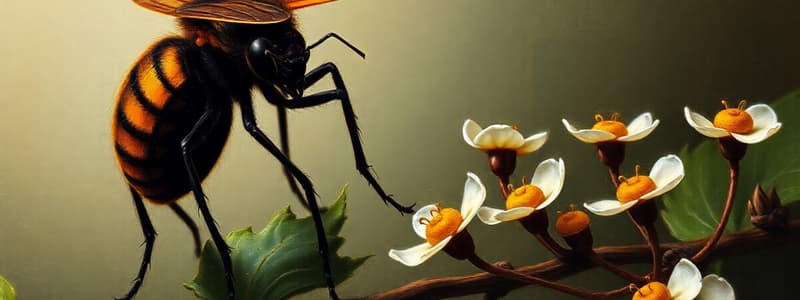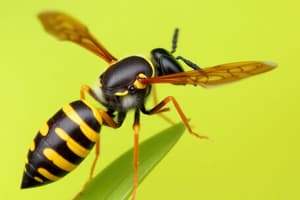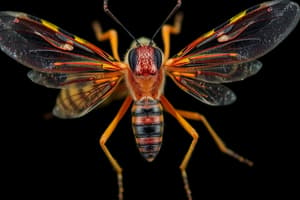Podcast
Questions and Answers
What is a notable feature of the mouthparts of Tabanids?
What is a notable feature of the mouthparts of Tabanids?
- Slashing and sponging (correct)
- Collecting pollen
- Chewing and grinding
- Suction and piercing
Which of the following statements is true regarding Melophagus ovinus?
Which of the following statements is true regarding Melophagus ovinus?
- It is blood-sucking and lives its entire life on the host. (correct)
- It has wings and is a large fly.
- It primarily infests cattle.
- It requires a separate life cycle outside its host.
What type of hypersensitivity is associated with Cuterebra spp.?
What type of hypersensitivity is associated with Cuterebra spp.?
- Type IV hypersensitivity
- Type I hypersensitivity (correct)
- Type III hypersensitivity
- Type II hypersensitivity
What is a distinctive characteristic of the larvae of Cochliomyia hominivorax?
What is a distinctive characteristic of the larvae of Cochliomyia hominivorax?
Which species is currently recognized as a zoonotic concern affecting sheep?
Which species is currently recognized as a zoonotic concern affecting sheep?
What is the primary site of infestation for Sarcophagidae?
What is the primary site of infestation for Sarcophagidae?
Which of the following best describes the life cycle of the dog biting louse, Trichodectes canis?
Which of the following best describes the life cycle of the dog biting louse, Trichodectes canis?
What common name is associated with Cochliomyia hominivorax?
What common name is associated with Cochliomyia hominivorax?
What preventive measures can help manage screwworm infestations?
What preventive measures can help manage screwworm infestations?
Which of the following characteristics is true about the suborder Ischnocera?
Which of the following characteristics is true about the suborder Ischnocera?
What type of tissue do Sarcophagidae females prefer to lay their eggs in?
What type of tissue do Sarcophagidae females prefer to lay their eggs in?
What is the effect of heavy infestations of Trichodectes canis in neglected animals?
What is the effect of heavy infestations of Trichodectes canis in neglected animals?
What is the primary site of infestation for Cochliomyia hominivorax?
What is the primary site of infestation for Cochliomyia hominivorax?
What clinical sign is commonly associated with an infestation of Cochliomyia hominivorax?
What clinical sign is commonly associated with an infestation of Cochliomyia hominivorax?
What should be done immediately upon diagnosis of Cochliomyia hominivorax infestation?
What should be done immediately upon diagnosis of Cochliomyia hominivorax infestation?
What is one method of treatment and prevention for Cochliomyia hominivorax?
What is one method of treatment and prevention for Cochliomyia hominivorax?
What is the recommended action for handling dipteran larvae after diagnosis?
What is the recommended action for handling dipteran larvae after diagnosis?
When did the outbreak of Cochliomyia hominivorax begin in the US?
When did the outbreak of Cochliomyia hominivorax begin in the US?
Which species is affected by the Cochliomyia hominivorax outbreak in Florida?
Which species is affected by the Cochliomyia hominivorax outbreak in Florida?
What is a common pathogenesis associated with Cochliomyia hominivorax?
What is a common pathogenesis associated with Cochliomyia hominivorax?
Flashcards are hidden until you start studying
Study Notes
Tabanids
- Horse flies and deer flies are large flies that bite domestic and wild animals, humans, small mammals, and birds.
- Their mouthparts are adapted for slashing and sponging, resulting in painful bites.
- Deer flies are particularly known to bite horses in shaded areas.
Melophagus ovinus
- This species is a common parasite of sheep.
- It is a flattened, hairy, and wingless fly that sucks blood from the host.
- The entire life cycle occurs on the host, making it difficult to control.
- It may be mistaken for ticks due to its shape and flattened body.
Cuterebra spp.
- These are rodent and rabbit bot flies, also known as New World skin bot flies.
- They are zoonotic, meaning they can infect multiple hosts, including humans.
- Larvae develop in subcutaneous connective tissue, causing irritation and swelling.
- The third instar larvae must be manually removed, and this can sometimes cause severe allergies (Type I hypersensitivity).
Hypoderma spp.
- Adults of this species are known as warble flies, heel flies, or ox warbles.
- Larvae are known as cattle grubs.
- The primary host is cattle.
- First instars of H. lineatum develop in the submucosa of the esophagus, while H. bovis larvae develop in the epidural fat of the spinal cord.
- Third instar larvae create characteristic lumps on the backs of cattle.
- Timing treatment is crucial for effective control.
Oestrus ovis
- This fly is known as the sheep nasal bot.
- It parasitizes sheep and is occasionally zoonotic.
- First instar larvae are deposited by the female during flight directly into the host's nasal passages.
- Larval irritation causes “snotty nose” in sheep.
- In rare cases, larvae can migrate abnormally, potentially reaching the brain.
Gasterophilus spp.
- These bot flies parasitize horses.
- Larvae develop in the stomach or small intestine, causing discomfort and irritation.
- Different species can be differentiated based on the color and spines of their larvae.
- Adult flies are often referred to as "fly worry" as they are known to constantly harass horses.
Cochliomyia hominivorax
- This fly is commonly known as the screwworm.
- It infests livestock and wildlife.
- It is a 10 mm long, bluish-green fly with three stripes on its thorax and orange-brown eyes.
- Adults mate only once in their lifetime.
- Female flies lay eggs on fresh, uninfected wounds.
Cochliomyia hominivorax Life Cycle
- Larvae infest and feed on living tissue.
- They are a serious threat to livestock and wildlife, causing rapid tissue damage and death.
- The infestation typically starts with fresh wounds that attract female flies.
- The infested area develops a foul odor and quickly becomes infected.
Cochliomyia hominivorax Diagnosis and Treatment
- Diagnosis is typically made by recognizing the maggots in lesions.
- Prompt reporting to veterinary authorities is crucial.
- Treatment involves disinfecting wounds and releasing sterile male flies.
- Screwworm outbreaks are a major concern, and recent outbreaks in Florida highlight the importance of monitoring and control.
Sarcophagidae
- These flies are commonly known as flesh flies.
- They are found worldwide and can infest any animal.
- Adults are twice the size of house flies.
Sarcophagidae Life Cycle
- Females lay first instar larvae in sores, wounds, and necrotic tissues.
- Larvae develop into third instars and then leave the host to pupate.
- Pupae are the overwintering stage.
- The primary sites of infestation are skin and wool.
Sarcophagidae Prevention and Control
- Prevention involves maintaining good hygiene and husbandry practices, including sanitation, improved housing, and tail docking.
- Promptly treat wounds to prevent fly infestation.
Ischnocera (Mallophaga)
- These are chewing lice, characterized by their biting mouthparts.
- They are host-specific and spend their entire life cycle on the host.
- They typically feed on skin, hair, feathers, and other organic material.
- They are relatively small, approximately 3 mm long, and have a yellowish color.
- They move rapidly over the host's skin and covering.
Trichodectes canis
- This louse is commonly known as the dog biting louse or canine chewing louse.
- It parasitizes dogs.
- It is yellowish, with biting mouthparts.
- It is an active louse, with adults reaching 2 mm in length.
Trichodectes canis Life Cycle
- Females lay eggs, which develop into nymphs and eventually adults.
- They require a host to complete their life cycle.
Trichodectes canis Pathogenesis and Clinical Signs
- Heavy infestations are common in neglected and underfed dogs, especially young animals.
- They are known to transmit Dipylidium caninum (a tapeworm) to dogs.
- The primary clinical sign is severe itching (pruritus), which causes dogs to scratch excessively, leading to hair loss.
Trichodectes canis Diagnosis and Treatment
- Diagnose by identifying the louse.
- Treatment involves avoiding contact with infected brushes, combs, and blankets, and administering macrocyclic lactones.
Felicola subrostratus
- This is the common cat biting louse.
- It parasitizes cats.
- It is beige or yellow, with transverse brown bands.
- The head is triangular, and the legs are small.
- Adults are 1-1.5 mm long.
Felicola subrostratus Pathogenesis and Diagnosis
- Infestations are more common in elderly or chronically ill cats, and longhaired breeds are particularly susceptible.
- Diagnose by identifying the louse.
Bovicola (Damalinia) bovis
- This louse is the cattle biting louse.
- It parasitizes cattle.
- It is a typical Ischnoceran louse, with a reddish-brown color.
- The primary site of infestation is the head, poll, neck, shoulders, rump, and tail switch.
Bovicola (Damalinia) bovis Life Cycle
- Louse numbers are highest during winter, with dense coats, indoor housing, and parthenogenesis.
- Numbers are lower in summer due to thin coats, higher skin temperatures, and sunlight being lethal to lice.
Bovicola (Damalinia) bovis Pathogenesis and Clinical Signs
- In large numbers these lice cause chronic dermatitis, irritation, itching, and pruritus.
- They can negatively affect the host’s body condition and fleece quality.
- Their presence can also be a secondary sign of malnutrition or chronic disease.
Bovicola (Damalinia) bovis Diagnosis and Treatment
- Diagnose by identifying the louse.
- Treatment involves administering various ectoparasiticides, including macrocyclic lactones.
Bovicola (Damalinia) ovis
- This louse is the biting louse of sheep.
- It parasitizes sheep.
- It is a typical Ischnoceran louse.
- It is the most pathogenic of all sheep lice, causing damage to fleece and attracting blow flies.
Bovicola (Damalinia) ovis Diagnosis and Treatment
- Diagnose by identifying the louse.
- Numerous treatments are effective.
Bovicola (Damalinia) caprae
- This louse is known as the red louse.
- It parasitizes goats.
- It is similar to Bovicola ovis.
Bovicola (Damalinia) equi
- This louse parasitizes horses and is similar to Bovicola ovis.
Ischnocera - Avian Lice
- These are biting and chewing lice that parasitize domestic and wild birds.
- There are over 40 species of these avian lice.
- The primary site of infestation can vary, with lice being categorized based on their preferred location, such as the wing or body.
Ischnocera - Avian Lice Pathogenesis and Clinical Signs
- Lice digest keratin and bite feathers.
- Infestation causes sleeplessness, loss of appetite, scratching, and feather plucking.
- Secondary effects, such as bacterial or fungal infections, can be more serious than the direct damage caused by lice.
Ischnocera - Avian Lice Diagnosis
- Diagnose by identifying the louse.
Studying That Suits You
Use AI to generate personalized quizzes and flashcards to suit your learning preferences.



